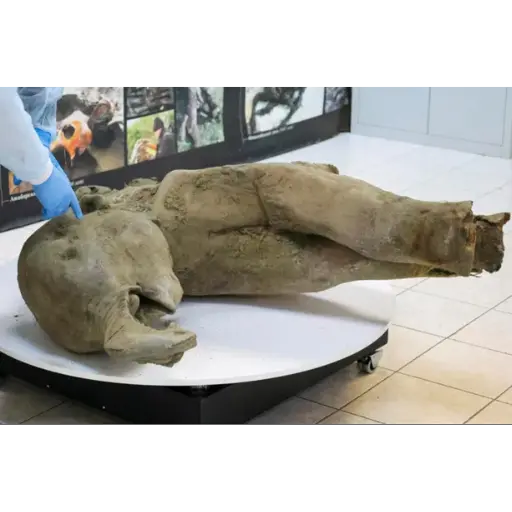Scientists Unveil Remarkably Preserved 50,000-Year-Old Baby Mammoth

The frozen tundra of Siberia has yielded a spectacular find: the remains of a 50,000-year-old baby mammoth, named “Yana,” discovered in the permafrost of Yakutia’s remote Batagaika crater.
A Remarkable State of Preservation
Dubbed the best-preserved mammoth ever found, Yana’s remains are nearly intact, thanks to the icy conditions of Siberia. The young mammoth, estimated to have been about one year old at the time of death, weighs over 100 kilograms (220 pounds), stands 120 centimeters (4 feet) tall, and measures 200 centimeters (6.5 feet) in length.
While some parts of Yana’s body, such as her forelimbs, were consumed by predators, her head and other features remain remarkably well-preserved.
Discovery in the World’s Largest Permafrost Crater
Yana was unearthed by local residents near the Batagaika crater, the world’s largest permafrost depression. Maxim Cherpasov, head of the Lazarev Mammoth Museum Laboratory, credited the find to the residents’ quick action.
“They were in the right place at the right time and created a makeshift stretcher to recover the mammoth,” Cherpasov explained.
The trunk and softer tissues, which typically thaw first and fall prey to predators, were found intact—a rarity in discoveries of this kind.
How Yana Was Preserved
Researchers believe Yana likely became trapped in a swamp tens of thousands of years ago. Gavril Novgorodov, a researcher at the museum, noted:
“The swamp conditions likely led to her remarkable preservation over millennia.”
Insights Into Prehistoric Life
Yana is currently undergoing tests at the North-Eastern Federal University in Yakutsk to confirm her precise age and provide more details about her life and environment.
This discovery is one of only seven well-preserved mammoth carcasses ever found—five in Russia and one in Canada.
Climate Change and New Discoveries
The thawing permafrost of Siberia has revealed numerous prehistoric creatures in recent years, including:
- A 32,000-year-old sabre-tooth cat uncovered in the same region just last month.
- The remains of a 44,000-year-old wolf, discovered earlier this year.
As climate change accelerates the melting of frozen ground, scientists anticipate further glimpses into prehistoric ecosystems.
This latest discovery not only enhances our understanding of mammoths but also underscores the fragility of Earth’s icy regions.






